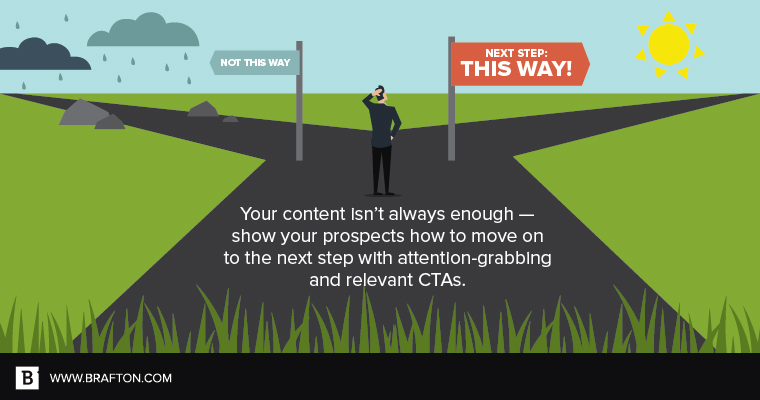To quote one of the movie classics: “If you build it, he will come.”
Marketers aren’t exactly looking to have a team of yesteryear baseball players come to their blogs, but there’s truth in this phrase in the context of content marketing. If you spend time and resources building an effective company blog, people will come to it.
However, there’s one thing the main character in “Field of Dreams” didn’t have to worry about: Once those people come to you, how do you transform them into leads?
Sure, you’ve got blog posts that are filled with thought leadership and industry analysis, and they’re giving your readers the information they’re looking for. But that isn’t always enough to convert. You’ve also got to focus on how you’re encouraging visitors with your calls to action, whether it’s to download a white paper, schedule a demo or talk directly with your sales team.
How the blog conversion game has changed
By designing powerful CTAs for your blog, you can significantly increase your lead generation efforts. But first, you’ve got to determine what kind of conversions you can expect from your blog.
Are you looking for hard conversions, such as demo requests or contact form submissions that show strong intent? Or do you want something on the softer side, such as asset downloads or newsletter sign-ups that are all about strong interest?
Back in the not-so-distant past, blogs were mainly used as tools for building brand awareness and driving traffic to your website, and most of the leads generated were considered soft conversions. While blogs are still used for boosting awareness and traffic, they’ve also grown into resources for providing in-depth analysis and insight. This, said Brafton SEO & Digital Marketing Consultant Casey Brusch, is what has turned blogs from top-of-funnel tools into top-to-mid-funnel assets.
“What used to work in blogs, such as light articles focused more on keyword rankings, doesn’t work anymore,” she explained. “Now, for a blog to be successful for users and rankings, it should cover a topic in depth, which can bring people further down the funnel. Blogs can’t be fluff pieces anymore. Brands need to put time and energy into their them.”

CTA know-how
However, that time and energy might be wasted if you’re not also focusing on your CTAs. After all, your readers won’t move on to the next step if they don’t know how or if they aren’t encouraged to with the right guidance.
Using the right language
Whether you’re aiming for those soft or hard (or a mix of both) conversions, make sure your CTA is relevant to what you’re offering in your blog, said Brafton Senior Designer Courtney Meyer.
For example, if your blog provides more general information, make your CTA an email subscribe sign-up. If another blog dives a lot deeper into a specific topic, give readers a CTA that encourages them to contact your brand for a demo or call.
Casey agreed with this, saying CTAs must focus on user intent. “You need a CTA that’s relevant to the blog content and that provides value to users by addressing what people came to your page to find. Try asking yourself, ‘Who would look for an article with this information and what more might they want to know? How do my products/services fit into that mix?'” she said. “It needs to address what people came to your page to find.”
CTA real estate
CTAs won’t be effective unless you’re placing them in the right spot. And there is no perfect CTA location for every brand. This is why you’ve got to test out different placements and find one that works.
“Brafton has seen a lot of success with pop-up CTAs recently,” Casey said. “However, what works for us won’t work for everyone. Companies need to constantly conduct A/B testing to see what gets the best results because there’s no hard and fast rule for CTA placement.”
As stated above, Brafton is one prime example. Courtney explained that before Brafton moved to pop-up CTAs, the subscribe button was smaller and located on the side of the page, which meant it could be easily missed.
But now, after a series of A/B testing, we found that pop-ups work better. In fact, we saw an increase of 523 percent in daily subscriptions. Whoa.
Needless to say, we were pretty stoked with the results, and they just go to show that you’ve got to keep on testing. If a pop-up isn’t doing wonders for your blog, try a sidebar CTA. If the sidebar isn’t working, try bottom of the page. Keep trying new placement options and you’re bound to find that CTA sweet spot.
Color it up
Your visitors have a lot to look at on a page. That’s why you’ve got to make sure your CTA stands out. Courtney suggested going bold and bright.
“The brighter the color, the more people are going to click on it,” she said. “Use contrasting colors to really make a CTA pop and draw your visitors’ eyes to it.”
But just like with CTA placement, one color is not going to work for every brand. Casey said you should also test out different colors to see what works best. For Brafton, that color is green. But for another company (such as this one), orange brought in a 33 percent boost in conversions.
Your CTAs are just as important as the content your visitors are consuming. Make sure you are successfully guiding your prospects to the next step by creating attention-grabbing and relevant CTAs.





